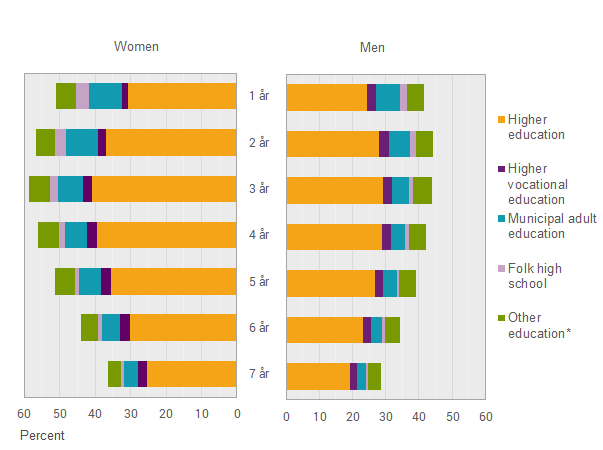Gender disparity in educational choices after upper secondary school
Statistical news from Statistics Sweden 2019-04-03 9.30
Women and men make different educational choices after upper secondary school. Women continue to study to a greater extent and seven years after upper secondary school, they have occupations that require higher education qualifications to a greater extent.
The statistics are based on a study in which Statistics Sweden has examined the direction that persons born 1990 have taken after they completed upper secondary education. The results are presented in a report that focuses on gender disparity with regard to choices of further studies, integration on the labour market and employment in relation to the subjects studied in upper secondary school.
Further studies after upper secondary school
In total, women continued their studies in municipal adult education, folk high school and higher education to a greater extent than men, who to a greater extent studied at higher vocational education. For example, among women 64 percent were enrolled in a higher education programme at some point after upper secondary school, compared with 48 percent of the men.
Results of this study show that students who had completed the upper secondary school child recreation programme to a greater extent studied in a municipal adult education, while those who had completed the arts programme most often studied at a folk high school. Students who had completed the electrical engineering programme were those with the largest share of students who studied at higher vocational education, while those who had completed the natural sciences programme most often studied in higher education.
Gender disparity in educational choices in higher education
The most common principal field that people, women to a greater extent than men, chose to study in was social sciences, law, business and administration. The second most common field of study, and also the field with most men, was engineering, manufacturing and construction. This was followed by health and welfare, which was also the field with most women.
Gender disparity is also evident in each principal field. For example, among those who studied education, it was more common for women to choose teaching programmes for compulsory school age groups up to grade 6, preschool and leisure activities. Among men who studied the same principal field, it was more common to study to be a subject teacher.
Women enter the labour market later
On the whole, women continued their studies after upper secondary school to a greater extent than men, while men started to work instead and entered the labour market at an earlier stage. Three years after upper secondary school, 39 percent of the men were integrated on the labour market, compared with 26 percent of the women. However, the differences are to a large extent a result of educational choices after upper secondary school. For obvious reasons, persons who did not continue to study also entered the labour market to the largest extent in the first years after upper secondary school. From the fourth year after upper secondary school, persons who had studied in higher vocational education directly after upper secondary school had integrated on the labour market to the greatest extent.
Furthermore, a comparison of employed persons' occupations seven years after upper secondary school shows that women to a greater extent than men had an occupation that required both basic and in-depth higher education qualifications.

* Other education includes: Studies abroad for which financial aid was received, technical base year at an institution of higher education, employment training, Swedish for immigrants (SFI) or supplementary education programmes.
Definitions and explanations
The establishment measure is, in part, based on income; the upper and lower economic boundaries are adjusted yearly. For a person to count as established on the labour market in 2016 required a labour income of at least SEK 191 800, employment as defined in the Employment Register (November 2016), no events that indicate unemployment or labour market policy measures that are not regarded as employment.
Publication
A more detailed presentation of the results is published in the thematic report Educational choices after upper secondary school – gender differences among persons born in 1990 (pdf)
Feel free to use the facts from this statistical news but remember to state Source: Statistics Sweden.
